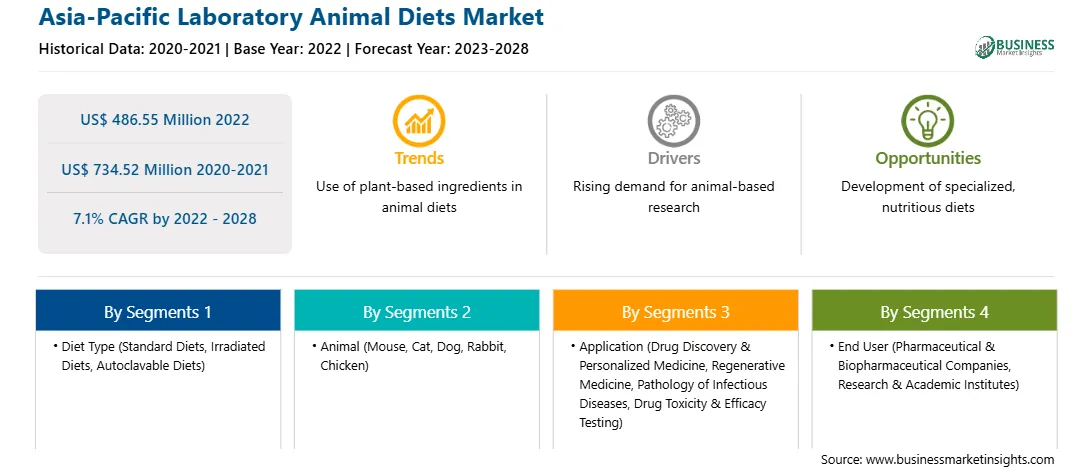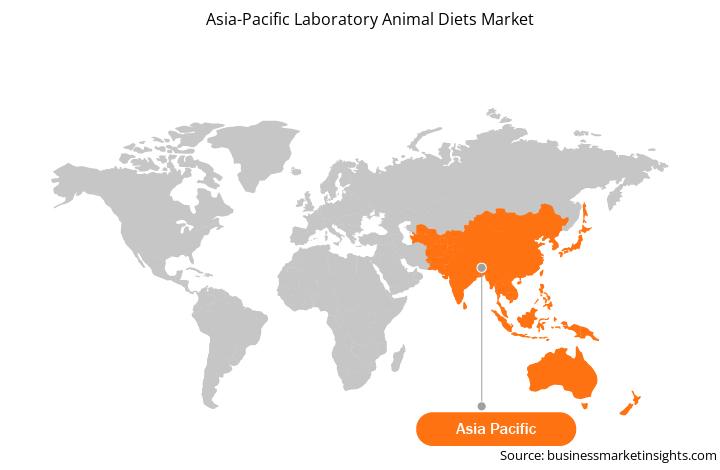The laboratory animal diets market in APAC is expected to grow from US$ 486.55 million in 2022 to US$ 734.52 million by 2028; it is estimated to grow at a CAGR of 7.1% from 2022 to 2028.
Growing Inclination Toward Customized Diet Plan for Laboratory Animals to Bolster APAC Laboratory Animal Diets Market
Customized diets are fed to animals for controlling nutrients, inducing a disease, or using a dosing technique to treat the disease. Customized diets consist of refined ingredients which supply one major nutrient class such as casein, starches and sugar, fats and oils, and cellulose, and then micronutrients are added according to the requirement. The levels and types of nutrients and micronutrients are manipulated according to the necessity of the research purpose. For instance, if a zinc-deficient diet is required, the casein is replaced by egg white solids, as they are low in zinc. It is highly recommended that researchers using a custom diet for a new project must collaborate with a trusted nutritionist. These professionals can formulate diets with specific additions or deficiencies, including diets designed to mimic human dietary intakes. Sharing a researcher’s expertise on a particular research subject, coupled with the knowledge of nutrition, ingredients, and diet manufacturing, can make a custom diet a precision tool for creating experimental conditions that answer complex research questions. Due to the ongoing research on diseases such as metabolic diseases and cancer, the preference for a customized diet is increasing compared to a standardized diet.
Market Overview
The Asia Pacific laboratory animal diets market is segmented into China, India, Japan, South Korea, Australia, and the Rest of APAC. The region is witnessing an increasing number of world-leading mouse genetics research centers and facilities. Advances in genomic research have offered several benefits to the pharmaceutical industry owing to the use of animals in the vaccine discovery procedures that lead to the replacement of genetically-modified animals. The rising number of animal model applications in the healthcare domain in APAC would boost the market growth in the coming years. In addition, China has access to huge colonies of monkeys and other species. Thus, scientists in China face less public inspection than in Europe and the US. China has become the center of the CRISPR animal kingdom, which is appealing to the researchers, and the Chinese government has massively invested in new services and determined research projects. Animal research in the country is regulated and administratively managed according to the national and provincial laws, regulations, guidelines, and standards. Laboratory animal science in China has developed rapidly over the past 30 years due to the government and societal forces, which are encouraging the research projects in the country. In China, the People's Congress is the legislature; therefore, the National People's Congress and provincial People's Congresses approve and issue national and provincial laws, respectively. According to the Institute of Laboratory Animal Sciences (ILAS), China uses ~20 million animals, such as mice, dogs, rabbits, and nonhuman primates, in research each year. Thus, increasing biomedical research utilizing laboratory animals is expected to fuel the laboratory animal diet market during the forecast period.
APAC Laboratory Animal Diets Market Revenue and Forecast to 2028 (US$ Million)
Strategic insights for the Asia-Pacific Laboratory Animal Diets provides data-driven analysis of the industry landscape, including current trends, key players, and regional nuances. These insights offer actionable recommendations, enabling readers to differentiate themselves from competitors by identifying untapped segments or developing unique value propositions. Leveraging data analytics, these insights help industry players anticipate the market shifts, whether investors, manufacturers, or other stakeholders. A future-oriented perspective is essential, helping stakeholders anticipate market shifts and position themselves for long-term success in this dynamic region. Ultimately, effective strategic insights empower readers to make informed decisions that drive profitability and achieve their business objectives within the market. The geographic scope of the Asia-Pacific Laboratory Animal Diets refers to the specific areas in which a business operates and competes. Understanding local distinctions, such as diverse consumer preferences (e.g., demand for specific plug types or battery backup durations), varying economic conditions, and regulatory environments, is crucial for tailoring strategies to specific markets. Businesses can expand their reach by identifying underserved areas or adapting their offerings to meet local demands. A clear market focus allows for more effective resource allocation, targeted marketing campaigns, and better positioning against local competitors, ultimately driving growth in those targeted areas.Asia-Pacific Laboratory Animal Diets Strategic Insights

Asia-Pacific Laboratory Animal Diets Report Scope
Report Attribute
Details
Market size in 2022
US$ 486.55 Million
Market Size by 2028
US$ 734.52 Million
CAGR (2022 - 2028) 7.1%
Historical Data
2020-2021
Forecast period
2023-2028
Segments Covered
By Diet Type
By Animal
By Application
By End User
Regions and Countries Covered
Asia-Pacific
Market leaders and key company profiles
Asia-Pacific Laboratory Animal Diets Regional Insights

APAC Laboratory Animal Diets Market Segmentation
The APAC laboratory animal diets market is segmented into diet type, animal, application, end user, and country.
Based on diet type, the market is segmented into standard diets, irradiated diets, and autoclavable diets. The standard diets segment registered the largest market share in 2022.
Based on animal, the APAC laboratory animal diets market is segmented into mouse, cat, dog, rabbit, chicken, and others. The mouse segment registered the largest market share in 2022.
Based on application, the APAC laboratory animal diets market is segmented into drug discovery and personalized medicines, regenerative medicines, pathology of infectious disease, drug toxicity and efficacy testing, and others. The drug discovery and personalized medicine segment registered the largest market share in 2022.
Based on end user, the APAC laboratory animal diets market is segmented into pharmaceutical & biopharmaceutical companies, research & academic institutes, and others. The pharmaceutical & biopharmaceutical companies segment registered the largest market share in 2022.
Based on country, the APAC laboratory animal diets market is segmented into China, Japan, India, Australia, South Korea, and the Rest of APAC. China dominated the market in 2022.
Altromin Spezialfutter GmbH & Co. KG, Bio-Serv, Envigo, Krishna Valley Agrotech LLP, LabDiet, Research Diets Inc., SAFE, Special Diet Services, and Specialty Feeds are the leading companies operating in the laboratory animal diets market in APAC.
The Asia-Pacific Laboratory Animal Diets Market is valued at US$ 486.55 Million in 2022, it is projected to reach US$ 734.52 Million by 2028.
As per our report Asia-Pacific Laboratory Animal Diets Market, the market size is valued at US$ 486.55 Million in 2022, projecting it to reach US$ 734.52 Million by 2028. This translates to a CAGR of approximately 7.1% during the forecast period.
The Asia-Pacific Laboratory Animal Diets Market report typically cover these key segments-
The historic period, base year, and forecast period can vary slightly depending on the specific market research report. However, for the Asia-Pacific Laboratory Animal Diets Market report:
The Asia-Pacific Laboratory Animal Diets Market is populated by several key players, each contributing to its growth and innovation. Some of the major players include:
The Asia-Pacific Laboratory Animal Diets Market report is valuable for diverse stakeholders, including:
Essentially, anyone involved in or considering involvement in the Asia-Pacific Laboratory Animal Diets Market value chain can benefit from the information contained in a comprehensive market report.